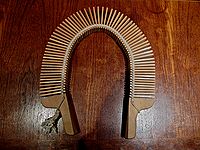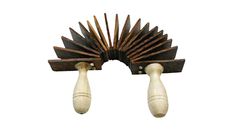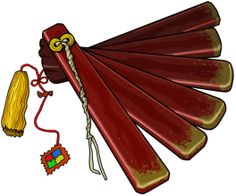As indicated in earlier blog postings, I regularly receive questions about percussion performance and history through email. Below are three such communications – Questions (Q) and my responses (A):
- Question about my ragtime xylophone arrangements
- Question about the clapper in “Rogosanti” by James Wood
- Question about a recording made by George Hamilton Green
Question 1) Received December 5, 2017
Q: I would like to inquire about the sales/performances of your works for novelty xylophone ragtime with marimba ensemble and with large ensembles. I would like to know which of your xylophone ragtime arrangements are most popular?
A: The most popular of my novelty ragtime arrangements, have been those composed by George Hamilton Green (and Joseph Green) which I arranged for NEXUS – both the unaccompanied versions as well as the versions with symphony orchestra/band accompaniment:
Fluffy Ruffles by G.H.Green/arr. W.L.Cahn
Xylophonia by J. Green/arr. W.L.Cahn
Dotty Dimples by G.H.Green/arr. W.L.Cahn
Nola by F.Arndt/arr. G.H.Green/arr.W.L.Cahn
Alabama Moon by G.H.Green/arr. W.L.Cahn
A Bunch of Roses by R.Chapi/arr. W.L.Cahn
The Ragtime Drummer by J.Lent/arr. W.L.Cahn
Frivolity by G.H.Green/arr. W.L.Cahn
Most of these are published by Keyboard Percussion (Malletech), and they have been performed many times worldwide since the 1970s by NEXUS in both the chamber and the large ensemble versions, as well as by student and professional percussion ensembles all over the world.
Q: How has that changed over the years?
A: Here’s a brief history of the xylophone in North American popular music.
1877 to 1930 – Music performed on the xylophone – including novelty ragtime music – reaches listeners worldwide, thanks to the influence of the new and emerging recording industry, culminating in a golden age that reaches a high point around 1930.
1930 to 1950 – As novelty ragtime music gives way to new generations of musical styles – swing, musical shows, and jazz – the xylophone gives way to the vibraphone, and all but disappears from popular music.
1950s through 1960s – thanks to the improved technical sound quality, Hi-Fi long-playing records feature the xylophone in the Hi-Fi percussion recordings of Harry Breuer and Sammy Herman. Morris Goldenberg also performs on xylophone in the very popular TV game show, Concentration. By the end of the 1960s, novelty ragtime music is generally viewed as passé (and even disparaged) in music schools. One exception is at the Eastman School of Music, where I had several lessons with Professor William G. Street on George Hamilton Green’s Arrangements of Famous Sam Fox Successes. In those lessons Mr. Street frequently reminisced about his duo xylophone performance(s) of Russian Rag (on a theme of Rachmaninoff arranged by Klickman) along with his brother Stanley, when both were in the Eastman Theatre Orchestra in the 1920s.
1970s to early 2000s – Novelty ragtime music played on the xylophone re-emerges thanks to the rediscovery of original recordings of George Hamilton Green by Bob Becker, myself and NEXUS. NEXUS re-introduces this music to the percussion world at Percussive Arts Society International Conferences, and through the NEXUS “Direct-to-Disc” recording, NEXUS Ragtime Concert.
2000 to present – While xylophone novelty ragtime music still remains popular with general audiences, percussion programs in music conservatories worldwide have shifted attention away from xylophone repertoire in favor of literature for the marimba. Paradoxically, this shift has occurred even as the technical ability for students to play in the ragtime style has generally increased, and a new generation of skilled xylophonists has appeared – largely thanks to the influence of Bob Becker’s performing and teaching.
Q: Do you believe that piracy and market saturation have affected sales significantly?
A: As with recorded music, photocopiers, computers and the internet have had a very significant negative impact on music publishing, making it very simple – even expected – to be able to reproduce printed music at little or no cost, thereby depriving publishers of significant income from sales.
Q: Also, would you like to give me a quote that I can use in my research paper about percussion ensemble? Something about your time from undergrad to just before forming Nexus would be perfect.
A: The percussion ensemble, as a significant worldwide musical niche, has arrived at a golden age, largely in sync with globalization – access to information and percussion music via the internet, easy and inexpensive jet travel for performing artists and instruments, and increased access to percussion instruments due to increased international trade.
Question 2) Received January 9, 2018
Q: This is to ask about the specific type of wood that is used for the clapper in “Rogosanti” by James Wood. I have not been able to find affordable bamboo in the quantity that I need., so I tried to decide between red oak and poplar. Poplar seems like it would be more flexible and less likely to break than oak.
A: The clapper in “Rogosanti” presents the type of problem that is typical of the unending myriad of problems faced by percussionists in virtually every genre of music to determine what sounds to make and how to make them. To be a successful percussionist is also to be a good problem solver, which requires creativity, resourcefulness, and when needed, access to a variety of materials and tools. To this day, almost every new piece I learn requires a significant amount of (non-playing) problem solving to get the right sound, placed optimally within the percussion setup.
When I was teaching at the Eastman School, one grad student needed to obtain a clapper for “Rogosanti”, but there was none readily available, and the best way to solve the problem was for me to make one for him, because I had access to materials and tools. It took the better part of a day to locate and assemble the materials and several more hours to experiment with tweaks to get the right sound.
I was fortunate to meet James Wood when we both served on the jury at the 2000 Tromp International Percussion Competition in Eindhoven, The Netherlands. The sound of the clapper for “Rogosanti” was likely derived by James Wood from hearing a Japanese Bin Zasara or Ita-sasara.
An excellent image of the kind of clapper needed for “Rogosanti” can be found on YouTube.
Go to – https://www.youtube.com/watch?v=AZlB723ciC4 (James Wood’s “Rogosanti”: performed by Victor Caccese). Scroll over to time code. 08:06 through 08:18. The clapper is at the lower right.
To build the clapper like this the following will be needed:
6 wooden slats (ea. about 1/4-inch thick, 10-inches long and 1.5-inches wide) tied together by a string drawn through a pair of holes drilled at one end of each of the slats. (Or, bolted together on one side onto a wooden base about 3/4-inch thick by 6-inches wide by 12-inches long.) On the string connection side, between each of the slats, is placed a thin strip of sheet-rubber (about 1/2-inch wide by 2-inches long). The slats are then tightened by the string (or a washer & nut) such that the slats will be separated on the opposite side. When struck, the slats on the open side come into a rapid sequence of contacts to make a rasping sound, and then immediately return back to the open position.
Regarding the type of wood suitable for the clapper, any hard wood should work. (just use the least expensive hardwood). Balsa wood is definitely too soft. Pine and even plywood might work too. Bamboo slats would work too if the bamboo is about 2-inches in diameter, with at least 10-inches between the nodes, and split in half lengthwise. Sometimes garden stores carry bamboo, but you’d have to call around. Good luck! Have fun!
Question 3) Received February 7, 2018
Q: I found an interesting record on the Japanese Columbia label. In the 1970s the Japanese ministry of education issued a record of “Dancing Stars” for children’s education. A video on YouTube at https://www.youtube.com/watch?v=MLI_jNof500 indicates that the performer is George Hamilton Green. As far as I know only Joe Green made about 6 recordings of this piece. Do you know which record company manufactured it in the U.S. or what the catalog number of this record is? I think the performer on this record might be Joe Green. It would be very interesting to know more about how this music and the xylophone were introduced into Japan.
A: The record shown on YouTube is definitely “Dancing Stars” composed by Joe Green, but PERFORMED by George H. Green.
(The performance is VERY ‘clean’ in rhythm and phrasing, which immediately makes me think it’s G.H.Green and not Joe Green.)
The Japanese recording is EXACTLY the same as the U.S.A. record, Columbia 783-D, because both were made from the same matrix. The U.S. matrix number is 142724. The Japan YouTube matrix number is 2142724. (See page 73 in my discography, “The Xylophone In Acoustic Recordings – 1877 to 1929”). The discography indicates that the performer was George Hamilton Green. It is an electric-process record made ca. 1926.
You can also hear Col. 783-D in my Archive of Xylophone Recordings (number 203), where it is also attributed to G.H.Green. The Archive is now located at the Center for Mallet Percussion Research at Kutztown University in Pennsylvania.
Regarding the history of the xylophone in Japan, I tried to obtain information when I was in residence at Showa (1998 to 2015), but it was very difficult, because I couldn’t find much printed material either in Japanese or English. It is certainly possible that Hiraoka had significant influence, since he toured outside of Japan and had a number of Japanese students.
In December 2012, I visited Professor Okada near Tokyo and he showed me a percussion method book by Sautaro Komori, which was clearly derived from American percussion method books, because it included some of the exact same plates for its fife and drum pieces that were likely borrowed from one or more American method books. The Komori book may also have been one of the earliest percussion methods published in Japan. There is more about my interview with Okada-sensei on my blog at the NEXUS website (www.nexuspercussion.com). The title of the blog is “A History of Western Percussion in Japan” (published on December 12, 2010).



